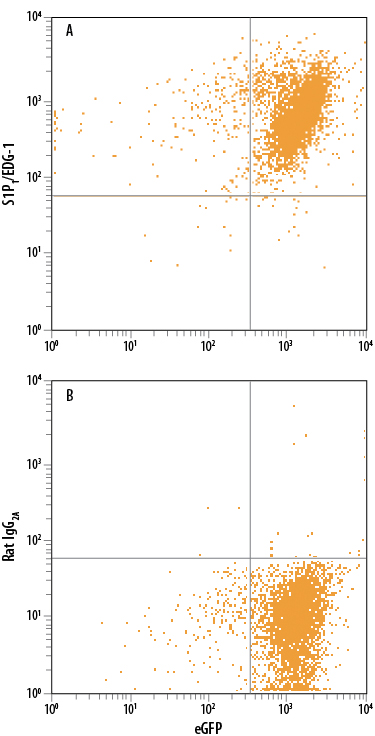Mouse S1P1/EDG-1 PE-conjugated Antibody Summary
Accession # O08530
Applications
Please Note: Optimal dilutions should be determined by each laboratory for each application. General Protocols are available in the Technical Information section on our website.
Scientific Data
 View Larger
View Larger
Detection of S1P1/EDG‑1 in HEK293 Human Cell Line Transfected with Mouse S1P1/EDG-1 and eGFP by Flow Cytometry. HEK293 human embryonic kidney cell line transfected with mouse S1P1/EDG-1 and eGFP was stained with either (A) Rat Anti-Mouse S1P1/EDG-1 PE-conjugated Monoclonal Antibody (Catalog # FAB7089P) or (B) Rat IgG2APhycoerythrin Isotype Control (Catalog # IC006P). View our protocol for Staining Membrane-associated Proteins.
 View Larger
View Larger
Detection of S1P1/EDG‑1 in Mouse Thymocytes by Flow Cytometry. Mouse thymocytes were stained with Rat Anti-Mouse CD4 APC-conjugated Monoclonal Antibody (Catalog # FAB554A) and either (A) Rat Anti-Mouse S1P1/EDG-1 PE-conjugated Monoclonal Antibody (Catalog # FAB7089P) or (B) Rat IgG2APhycoerythrin Isotype Control (Catalog # IC006P). View our protocol for Staining Membrane-associated Proteins.
Reconstitution Calculator
Preparation and Storage
- 12 months from date of receipt, 2 to 8 °C as supplied.
Background: S1P1/EDG-1
S1P1 (sphingosine 1-phosphate receptor-1), also known as EDG-1 (endothelial differentiation, G-protein coupled receptor-1) or S1PR1 (sphingosine-1-phosphate receptor 1) is a widely expressed, 37-40 kDa, G protein coupled receptor within the S1P subfamily of the EDG family. S1P1 is one of five receptors for the bioactive lipid S1P and mediates most of S1P effects on angiogenesis, vascular maturation, and cell migration, especially T cell egress from lymphoid organs. Human and mouse S1P1 share 84% amino acid identity within the N-terminal extracellular portion used as an immunogen.
Product Datasheets
Citations for Mouse S1P1/EDG-1 PE-conjugated Antibody
R&D Systems personnel manually curate a database that contains references using R&D Systems products. The data collected includes not only links to publications in PubMed, but also provides information about sample types, species, and experimental conditions.
5
Citations: Showing 1 - 5
Filter your results:
Filter by:
-
Neutral ceramidase-dependent regulation of macrophage metabolism directs intestinal immune homeostasis and controls enteric infection
Authors: R Sun, X Gu, C Lei, L Chen, S Chu, G Xu, MA Doll, Y Tan, W Feng, L Siskind, CJ McClain, Z Deng
Cell Reports, 2022-03-29;38(13):110560.
Species: Mouse
Sample Types: Whole Cell, Whole Cells
Applications: Flow Cytometry -
NLRP3 priming due to skin damage precedes LTP allergic sensitization in a mouse model
Authors: D Pazos-Cast, Z Gonzalez-K, AY Montalvo, G Hernandez-, A Romero-Sah, V Esteban, M Garrido-Ar, J Tome-Amat, A Diaz-Peral
Scientific Reports, 2022-02-28;12(1):3329.
Species: Human
Sample Types: Whole Cells
Applications: Flow Cytometry -
Fluvastatin-Pretreated Donor Cells Attenuated Murine aGVHD by Balancing Effector T Cell Distribution and Function under the Regulation of KLF2
Authors: K Zhao, Y Tian, J Wang, C Chen, B Pan, Z Yan, S Zhu, K Xu
BioMed Research International, 2020-12-19;2020(0):7619849.
Species: Mouse
Sample Types: Whole Cells
Applications: Flow Cytometry -
Role of the S1P pathway and inhibition by fingolimod in preventing hemorrhagic transformation after stroke
Authors: A Salas-Perd, F Miró-Mur, M Gallizioli, VH Brait, C Justicia, A Meissner, X Urra, A Chamorro, AM Planas
Sci Rep, 2019-06-05;9(1):8309.
Species: Human
Sample Types: Whole Cells
Applications: Flow Cytometry -
Normal Thymocyte Egress, T Cell Trafficking, and CD4(+) T Cell Homeostasis Require Interactions between RGS Proteins and G?i2
Authors: IY Hwang, C Park, K Harrison, JH Kehrl
J. Immunol, 2017-02-24;0(0):.
Species: Mouse
Sample Types: Whole Cells
Applications: Flow Cytometry
FAQs
-
Can staining with Mouse S1P1/EDG-1 conjugated Antibody, catalog # FAB7089*, be carried out at 4°C?
There is evidence that G protein family proteins require staining at room temperature (RT) or even 37 °C, so this is what we would recommend. Staining for 45 minutes is optimal with this antibody.
Reviews for Mouse S1P1/EDG-1 PE-conjugated Antibody
There are currently no reviews for this product. Be the first to review Mouse S1P1/EDG-1 PE-conjugated Antibody and earn rewards!
Have you used Mouse S1P1/EDG-1 PE-conjugated Antibody?
Submit a review and receive an Amazon gift card.
$25/€18/£15/$25CAN/¥75 Yuan/¥2500 Yen for a review with an image
$10/€7/£6/$10 CAD/¥70 Yuan/¥1110 Yen for a review without an image

